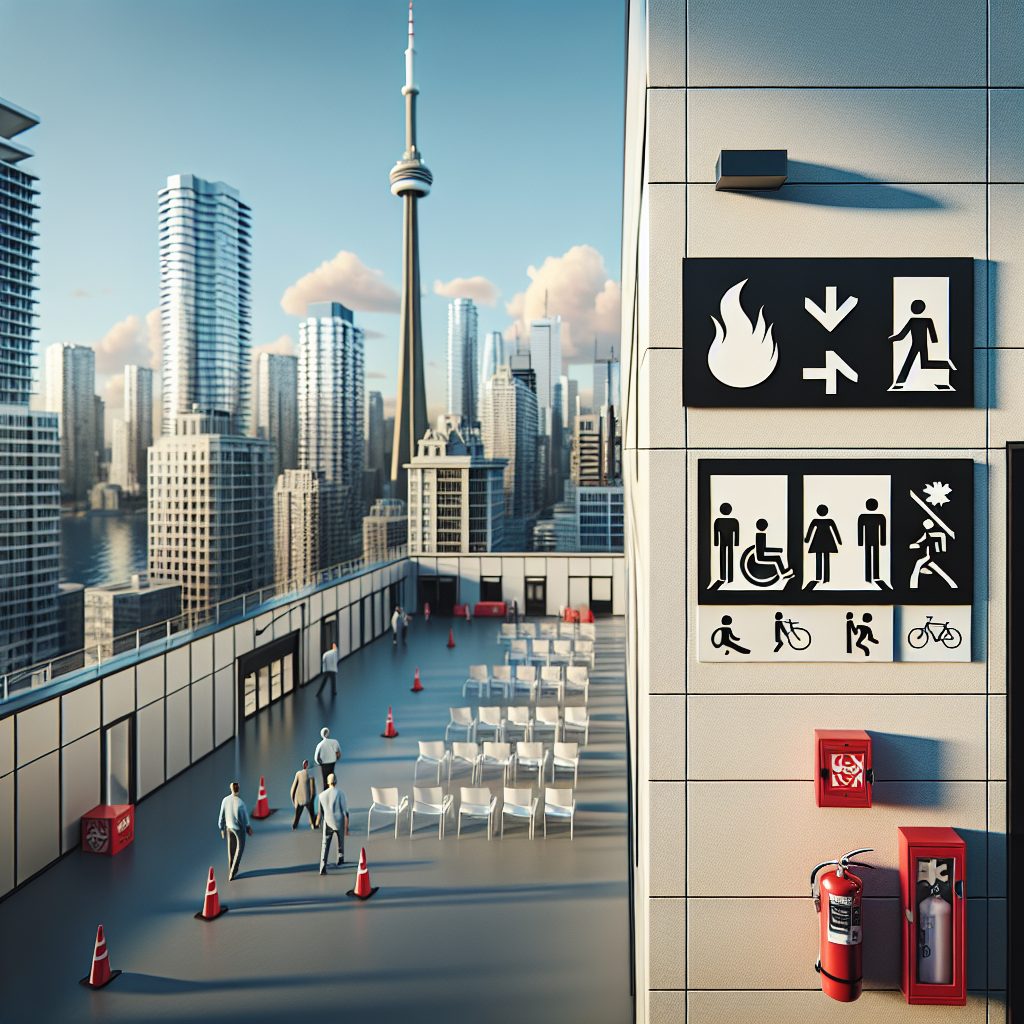Emergency access solutions for buildings in Toronto are crucial for ensuring the safety and security of occupants during unforeseen situations. These solutions encompass a range of measures and systems that facilitate efficient and effective emergency responses. One unique fact about emergency access solutions is that they are specifically designed to provide rapid and unobstructed access to emergency personnel, enabling them to swiftly reach those in need.
In the bustling city of Toronto, these emergency access solutions have a significant impact on the overall safety of its buildings. From high-rise commercial structures to residential complexes, the implementation of these solutions plays a vital role in minimizing the risks associated with emergencies such as fires, natural disasters, or any life-threatening incidents. Specialized features like emergency exits, fire alarms, escape routes, and well-maintained staircases are intricately integrated into the architectural designs of modern buildings to ensure swift evacuation during critical situations.
Moving forward, this article will delve into the key takeaways of emergency access solutions for buildings in Toronto. We will explore the various types of emergency access systems utilized in the city, their crucial role in enhancing safety measures, and the importance of regular maintenance and testing to ensure their functionality. By understanding the significance of these solutions, building owners, developers, and residents can make informed decisions to create a safer environment for all. Let’s dive into the details and uncover the essential aspects of emergency access solutions in Toronto.
Key Takeaways
1. Toronto’s buildings need to have effective emergency access solutions in place to ensure the safety and well-being of all occupants, especially during emergencies or crises.
2. The City of Toronto has implemented several regulations and standards to guide building owners and managers in providing adequate emergency access, including requirements for accessible routes, fire safety plans, and emergency exits.
3. Building owners and managers should regularly review and update their emergency access plans to ensure they comply with current regulations and best practices, identifying any potential barriers or limitations that may hinder accessibility during emergencies.
4. Collaboration and communication between building owners and emergency response agencies are crucial to ensure effective emergency access and response, emphasizing the importance of conducting drills, training staff, and coordinating with emergency services.
5. Implementing new technologies and innovative solutions can greatly enhance emergency access in buildings, such as the use of advanced locking systems that provide secure access to emergency responders while maintaining the safety and security of the building.
What are the top Emergency Access Solutions for Buildings in Toronto?
The Importance of Emergency Access Solutions
In a bustling city like Toronto, ensuring proper emergency access solutions for buildings is of utmost importance to ensure the safety and well-being of its residents. Emergency situations, such as fires or medical emergencies, can occur anywhere and at any time. Having efficient and reliable emergency access solutions in place can significantly reduce response time and save lives.
Access Control Systems
Access control systems play a crucial role in emergency access solutions for buildings in Toronto. These systems regulate entry and exit points, ensuring that authorized personnel have easy access to the building during normal operations while restricting unauthorized entry. By implementing access control systems, building managers can monitor and control access, making it easier for emergency responders to navigate within the building during crisis situations.
Emergency Exit Plans and Signage
Clear and well-marked emergency exit plans and signage are essential in every building in Toronto to guide occupants safely towards designated emergency exit points. These plans and signs should feature prominently on each floor, clearly indicating the nearest exits, assembly points, and necessary emergency contact numbers. Regular inspections and maintenance of emergency exit lighting and signage should also be conducted to ensure their visibility and functionality.
Emergency Backup Power Systems
Uninterrupted access to power during emergencies is crucial for effective emergency access solutions. Toronto buildings should equip themselves with backup power systems such as generators or uninterruptible power supply (UPS) units. These systems provide temporary power to essential equipment such as access control systems, emergency lighting, elevators, and communication systems, enabling smooth operations during power outages or other emergencies.
Enhanced Communication Systems
Clear and efficient communication systems are vital for emergency access solutions in buildings. Toronto structures should employ technologically advanced communication systems, including public address systems, emergency phones, two-way radios, or intercoms. These systems facilitate communication between occupants, emergency responders, and building management, ensuring timely dissemination of important information and instructions during emergencies.
Regular Training and Drills
It’s essential for building management to conduct regular training sessions and emergency drills to familiarize occupants with emergency access solutions. Toronto buildings should have comprehensive emergency response procedures in place, including evacuation plans and protocols. Regular drills allow occupants to practice these procedures, enabling them to respond quickly and efficiently during actual emergencies, minimizing panic and ensuring orderly evacuation.
- Ensure access control systems are properly maintained and regularly updated.
- Regularly inspect and test emergency exit lighting and signage.
- Conduct thorough risk assessments to identify potential emergency scenarios.
- Keep emergency contact information readily available in the building.
- Train building occupants on emergency response procedures.
- Conduct regular evacuation drills to ensure familiarity with emergency access solutions.
- Maintain a reliable backup power system to support essential equipment.
- Stay up to date with local building codes and regulations related to emergency access solutions.
- Monitor and upgrade communication systems as technology advances.
- Collaborate with emergency responders and local authorities to develop comprehensive emergency response plans.
FAQ
1. What are Emergency Access Solutions for Buildings?
Emergency Access Solutions for Buildings refer to the measures and systems put in place to ensure that people can safely access and exit a building in case of emergencies such as fires, natural disasters, or security threats.
2. What are the key components of an effective Emergency Access Solution?
An effective Emergency Access Solution for Buildings should include robust emergency exit plans, clear signage indicating emergency exits, well-maintained emergency lighting, easily accessible emergency exit doors, and training programs for building occupants and staff.
3. Are there specific regulations or codes related to Emergency Access Solutions in Toronto?
Yes, each city may have its own regulations and codes related to emergency access solutions. In Toronto, buildings are required to comply with the Ontario Building Code, which outlines the standards for emergency exits, signage, lighting, and various other aspects of emergency access solutions.
4. How often should emergency exit plans be reviewed and updated?
Emergency exit plans should be reviewed and updated regularly to ensure their effectiveness. It is recommended to review and update the plans at least once a year or whenever there are significant changes to the building layout or occupancy.
5. What should building occupants do during an emergency evacuation?
During an emergency evacuation, building occupants should remain calm, follow the instructions provided by emergency personnel or building management, proceed to the nearest emergency exit following the designated evacuation route, and gather at the designated assembly points outside the building.
6. Are there any technologies that can enhance Emergency Access Solutions?
Yes, there are various technologies available that can enhance Emergency Access Solutions for Buildings. These include fire alarm systems, smoke detectors, surveillance cameras, access control systems, and automated emergency lighting systems.
7. Can emergency exits be locked to prevent unauthorized access?
Emergency exits should never be locked from the inside to prevent unauthorized access. They should be easily opened from the inside at all times without the need for keys or special tools. However, some emergency exit doors may have panic hardware or devices that lock upon exit to prevent unauthorized entry from the outside.
8. How can building owners ensure compliance with emergency access regulations?
Building owners can ensure compliance with emergency access regulations by conducting regular inspections, audits, and training programs, hiring qualified professionals to review and assess the building’s emergency access systems, and staying updated on the latest regulations and codes.
9. Are there penalties for non-compliance with emergency access regulations?
Yes, non-compliance with emergency access regulations can result in penalties and fines. Additionally, failure to comply with these regulations can put occupants at risk during emergencies, potentially leading to legal liabilities for the building owner.
10. Can I retrofit my old building with modern emergency access solutions?
Yes, it is possible to retrofit old buildings with modern emergency access solutions. However, it is recommended to consult with professionals who specialize in building safety and emergency access systems to assess the feasibility and requirements of such retrofits.
Final Thought
Emergency Access Solutions for Buildings play a crucial role in ensuring the safety of occupants during emergencies. By implementing effective emergency exit plans, using state-of-the-art technologies, and complying with regulations, building owners can create a secure environment where people feel confident that they can evacuate safely when needed.
In Toronto, where buildings vary in size, age, and purpose, it is essential for building owners and managers to prioritize emergency access solutions and regularly review and update their plans. By doing so, they can protect lives, minimize property damage, and contribute to the overall resilience of the city’s infrastructure.






Recent Comments